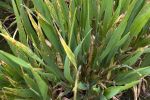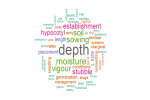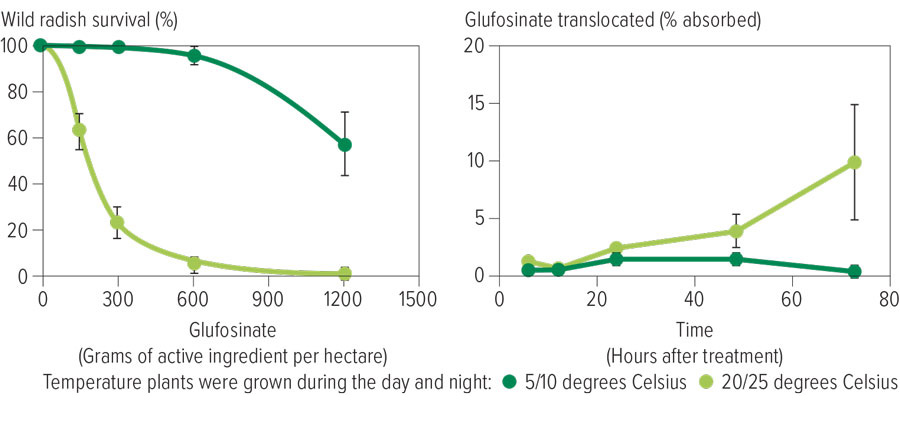Key points
- Random paddock surveys show glyphosate-resistant annual ryegrass is on the rise
- With paraquat resistance also building in annual ryegrass and flaxleaf fleabane, the knockdown herbicide glufosinate could be included in double knock applications under the right conditions
- High rates of glufosinate, applied through a camera sprayer with high water rates, may serve as a viable second application following an initial treatment with glyphosate
An expert in weeds management has outlined a potential approach for dealing with glyphosate and paraquat-resistant weeds
With glyphosate and paraquat facing resistance issues, Professor Chris Preston from the University of Adelaide has outlined the benefits and costs of glufosinate as a potential partner in the double knock.
Professor Preston discussed the future of the double knock at the Crop Protection Forum 2024* near Toowoomba, Queensland, last November. He said the double knock (applying glyphosate followed by paraquat one to five days later) was essential for managing glyphosate resistance.
However, concerns about the double knock have emerged with the rising number of glyphosate and paraquat-resistant weeds.
“A national GRDC weeds survey showed that 16 per cent of paddocks contained glyphosate-resistant annual ryegrass,” he said. “For feathertop Rhodes grass, only one of the 129 samples tested was not completely resistant to glyphosate.”
Is glufosinate an option in a double knock?
Professor Preston said that getting glufosinate to work as a knockdown herbicide was more challenging than glyphosate and understanding how to get the best out of it was vital for efficacy.
Figure 1: How herbicides move into plants.
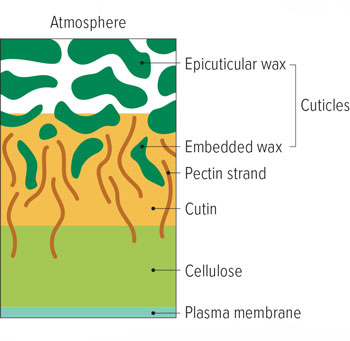
Source: Murtic, et al. 2012, via Chris Preston, the University of Adelaide
“The two herbicides share some chemical similarities, which means they are absorbed similarly by leaves,” he said. “However, they have differences in their ability to translocate through a plant.”
He said both herbicides were negatively charged, and when applying glyphosate, spray operators buffer water to a pH of 6 or less to help the herbicide work better. “To achieve the same effect with glufosinate, you need to lower the pH to about 2.5, which is impossible for growers.” He said herbicides entering plant leaves must pass through a waxy cuticle (Figure 1).
“If you ask water-soluble herbicides to pass through a waxy layer, it won’t happen. Pectin strands within the cuticle are essential for glyphosate, glufosinate and any other charged herbicide to enter a leaf.
Figure 2: Humidity is important in herbicide uptake.
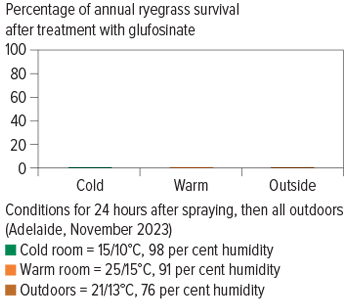
Source: Plant Science Consulting
“These strands are most common where cells join and around the stomata (tiny pores on the leaf). The pectin strands carry a negative charge, allowing positively charged herbicides like paraquat to enter quickly. However, negatively charged herbicides like glyphosate and glufosinate move through more slowly.”
Professor Preston said humidity was essential for herbicide uptake as it slows the drying of droplets and facilitates their absorption (Figure 2).
“Twenty-four hours after 2L/ha (200g of active ingredient/ha) of glufosinate was applied, annual ryegrass plants were placed outside or in a cold or warm room. Left outside, the humidity was 76 per cent, which led to 50 per cent control of the annual ryegrass.” He said a higher level of annual ryegrass control was achieved when the humidity exceeded 91 per cent for more than 24 hours.
Limiting factor
Professor Preston said the limiting factor for glyphosate was uptake into the plant. However, the limiting factor for glufosinate was its movement around the plant, also known as translocation (Figure 3).
“When glyphosate moves into a plant, it moves around it quickly, but glufosinate does not.”
He pointed to research examining the uptake of glufosinate by annual ryegrass compared with wild oats.
“Wild oats are about twice as easy to kill with glufosinate than annual ryegrass. This is because 80 per cent stays in the leaf, and 20 per cent moves to other leaves.
“In annual ryegrass, only 10 per cent of glufosinate moves. That’s why glufosinate struggles to control this weed.”
Temperature also affects the effectiveness of glufosinate, resulting in increased weed survival when the herbicide is applied at temperatures below 5°C (Figure 4).
“When wild radish is grown in warm conditions, we can control the weed with glufosinate; however, when it is grown in cold conditions, we cannot. Under cold conditions, less than one per cent of glufosinate was translocated through the plants.”
Figure 3: Translocation of glufosinate.
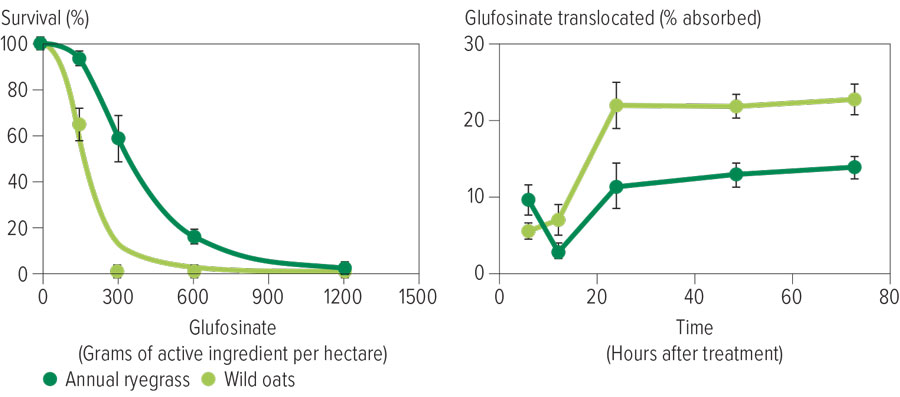
Source: Chris Preston, the University of Adelaide
Figure 4: Translocation of glufosinate reduced at cooler temperatures.
Source: Chris Preston, the University of Adelaide
Success factors
To improve the effectiveness of glufosinate, Professor Preston advised using the highest label application rate to enhance the translocation rate. Spraying during humid conditions, which usually occur in the mornings, with increased water rates, would also help.
“The highest label rate for glufosinate, when applied with more than 100L/ha of water, can effectively control weeds,” he said. “But it’s also important to spray small weeds.”
He said adding two per cent ammonium sulfate to the tank before loading glufosinate allowed the product to work more effectively.
“Glufosinate also tends to have more absorption in light, so spraying at night is less effective,” he said.
Pre-sowing application
Professor Preston said how glufosinate was used depended on the farming system.
“If you apply glufosinate as part of a double knock, there is a 14-day plant-back period, meaning that you need to use the herbicide as the initial step in the double knock, followed by a two-week wait before applying glyphosate.”
He said this allowed both herbicides to effectively control weeds, as glufosinate burns off the leaves, enabling the plant to regrow and produce new green leaves for glyphosate to target.
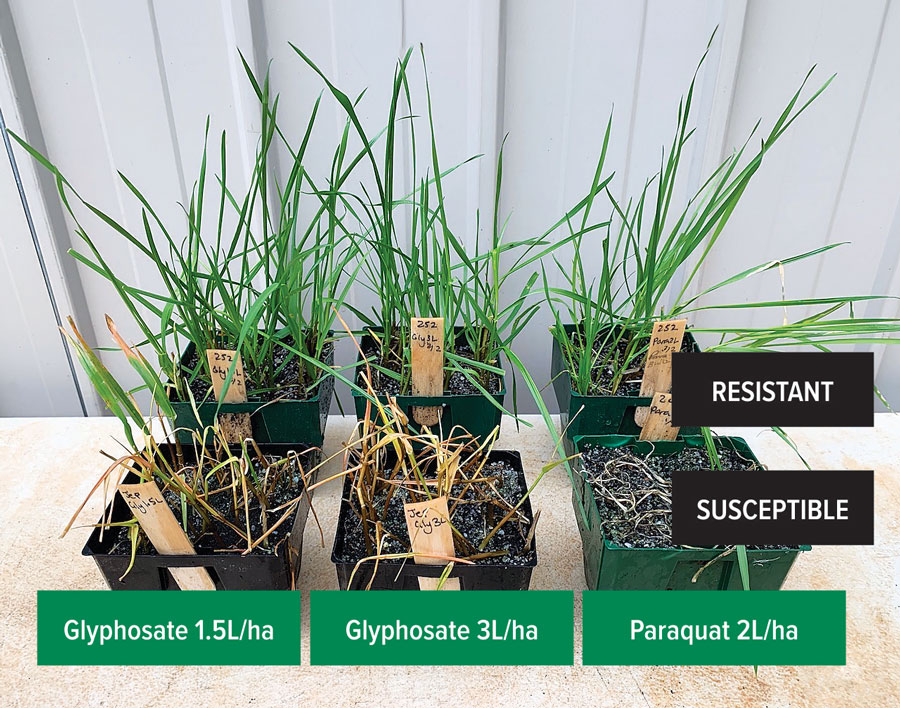
Herbicide-resistance testing has shown some annual ryegrass populations are already resistant to glyphosate and paraquat. Photo: Plant Science Consulting
Fallow use
Professor Preston said the Nufarm Biffo® (200g/L glufosinate-ammonium) label specified that 10L/ha of glufosinate could be applied using a camera sprayer in fallow.
“This method is effective against many weeds because it employs high rates that increase herbicide uptake.
“In this case, glyphosate would be the first knock in fallow, and a camera sprayer loaded with glufosinate plus high water rates would be the second.”
He said glufosinate followed by glyphosate as a double knock ahead of sowing would not be as cheap, easy or effective as glyphosate followed by paraquat.
“We probably need to explore more options to combine with glufosinate, such as a Group 14 herbicide for broadleaf weeds to improve its effectiveness and rapidly brown out tough weeds.”
He advised that most Group 14 herbicides could not be used through a camera sprayer and that labels should be consulted.
*GRDC supported the Crop Protection Forum 2024, hosted by the Centre for Crop and Disease Management, the Australian Herbicide Resistance Initiative and Cesar Australia.
More information: Chris Preston, christopher.preston@adelaide.edu.au

